Recently updated on May 8th, 2025 at 04:22 am
Every year, more than a million wildebeests sweep across the plains of Kenya and Tanzania, flanked by hundreds of thousands of zebras and gazelles – and a host of predators hot on their hooves. One of Earth’s most extraordinary wildlife migrations, this is more than a constantly shifting search for food – it’s an unfolding epic of instinct, endurance and survival, shaped by rain, terrain and seasonal rhythms.
And for wildlife lovers, witnessing the Great Migration is an immersion in nature at its most elemental. From the raw intensity of a Mara River crossing to the quiet power of new life on the Serengeti plains, it’s a year-round opportunity to experience nature’s rhythms at their most profound. So, here’s everything you need to follow the migration’s path for a safari holiday like no other.
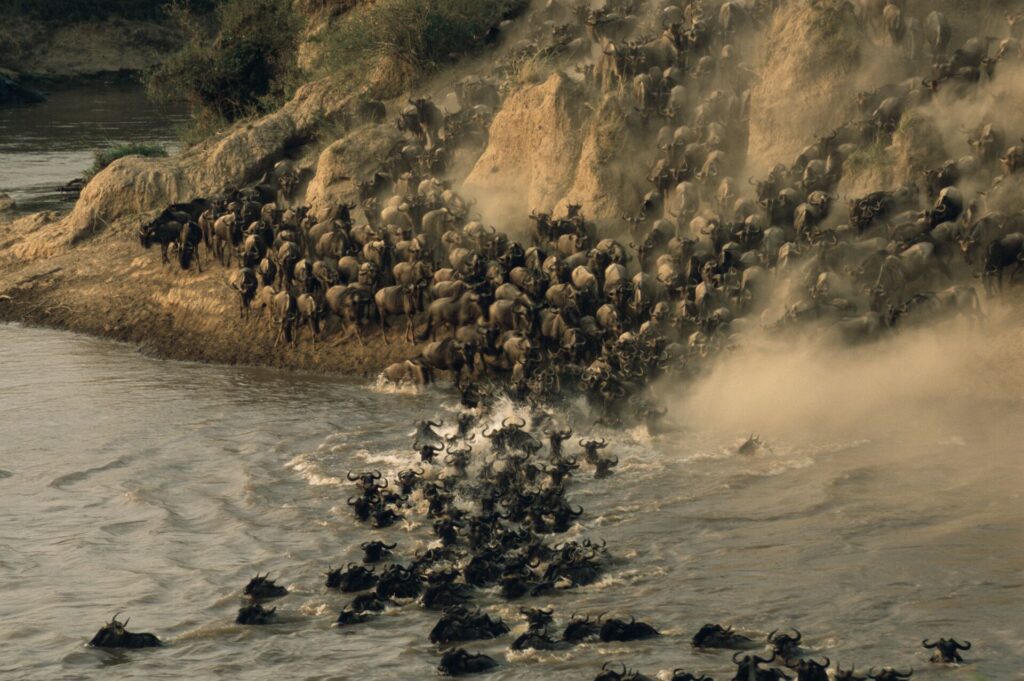

What Is the Great Migration?
The Great Migration is the continuous, clockwise movement of more than a million wildebeests – joined by zebras and antelopes – between the plains of Tanzania’s Serengeti National Park and Kenya’s Maasai Mara National Reserve. In their search for rain-ripened grass and fresh water, they travel some 2,500km, pausing to calve on the southern plains and brave the raging river crossings of the north.
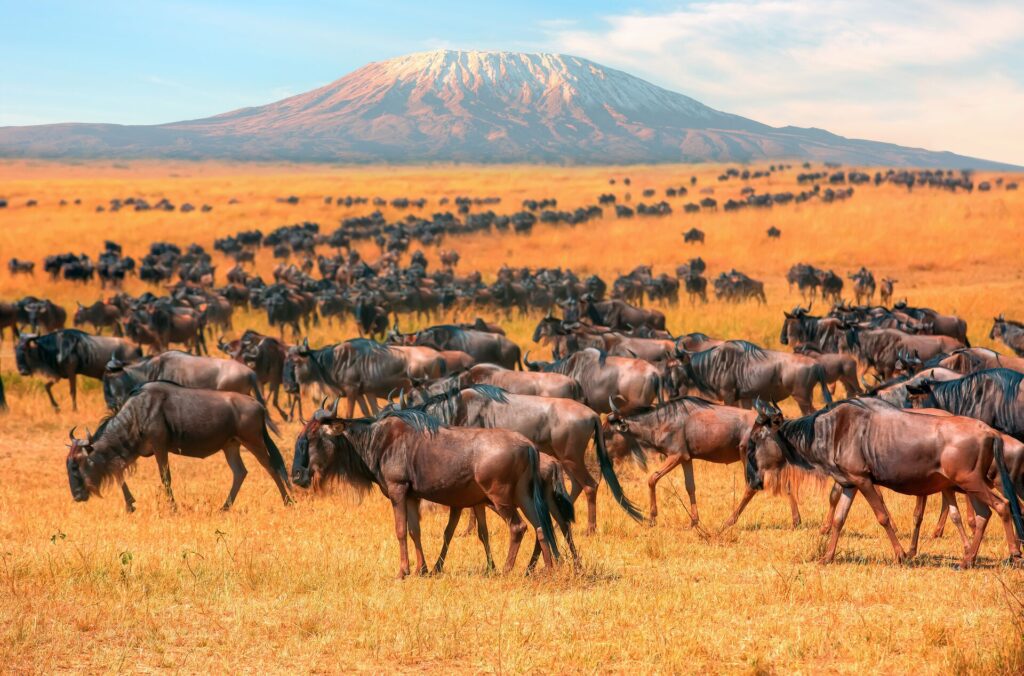

When Does the Great Migration Happen?
The Great Wildebeest Migration is in motion all year round, following seasonal rainfall and the life cycles of the savannah. Here’s how that unfolds:
January to March: Calving season in the Southern Serengeti
The year begins on the open plains of Tanzania’s Serengeti and parts of Ngorongoro, where the short November and December rains have left the landscape lush and primed for calving. In February and March, around 500,000 wildebeest are born here. The wildebeest herds mostly stay put to make the most of the grazing opportunities, but lions, cheetahs and hyenas lurk nearby, hoping to pick off the weak.
April to June: The long trek north begins
As the southern plains begin to dry out, the long rains reach the central and western Serengeti, bringing fresh grass shoots that lure the herds northwest. The migration now gradually moves through the central Serengeti before converging near the Grumeti River. Here, the wildebeests pause to graze and gain strength ahead of the next leg of their journey. Then, as the rains begin to trickle out, they slowly resume their push northward.
July to August: Mara River crossings in the Maasai Mara
The dry season sets in across both Tanzania and Kenya, so the wildebeests push north towards the Mara River. This is the most dramatic chapter of the migration as the herds gather along the riverbanks in the northern Serengeti before crossing into the Maasai Mara, with steep riverbanks, powerful currents, chaotic stampedes and hungry crocodiles making every crossing perilous. Not all survive, but the instinct to press on is stronger. By August, most of the herds have reached Kenya’s grasslands, where cooler temperatures and reliable dry-season grazing await.
September to October: Grazing in Kenya
With the river crossings behind them, the herds settle into the grasslands of the Maasai Mara. September and October bring dry landscapes and a sense of relative calm, as the animals disperse across the reserve, grazing and regaining strength. Predators remain active – especially as water becomes scarce and prey more vulnerable – so the wildebeests are constantly on the alert to avoid being ambushed.
November to December: Return south to Tanzania
The short rains in November bring new vegetation to the Serengeti plains, signalling the time to leave the Masai Mara. So, the herds begin their journey southward, crossing back over the Mara River and retracing their path through the Serengeti. By December, many have arrived back in its southern reaches, just in time for the next calving season to begin. And so, the rhythm continues – an extraordinary migration choreographed by rain, grass, and instinct.
See the Great Migration unfold across the Masai Mara and Serengeti on one extraordinary private tour.
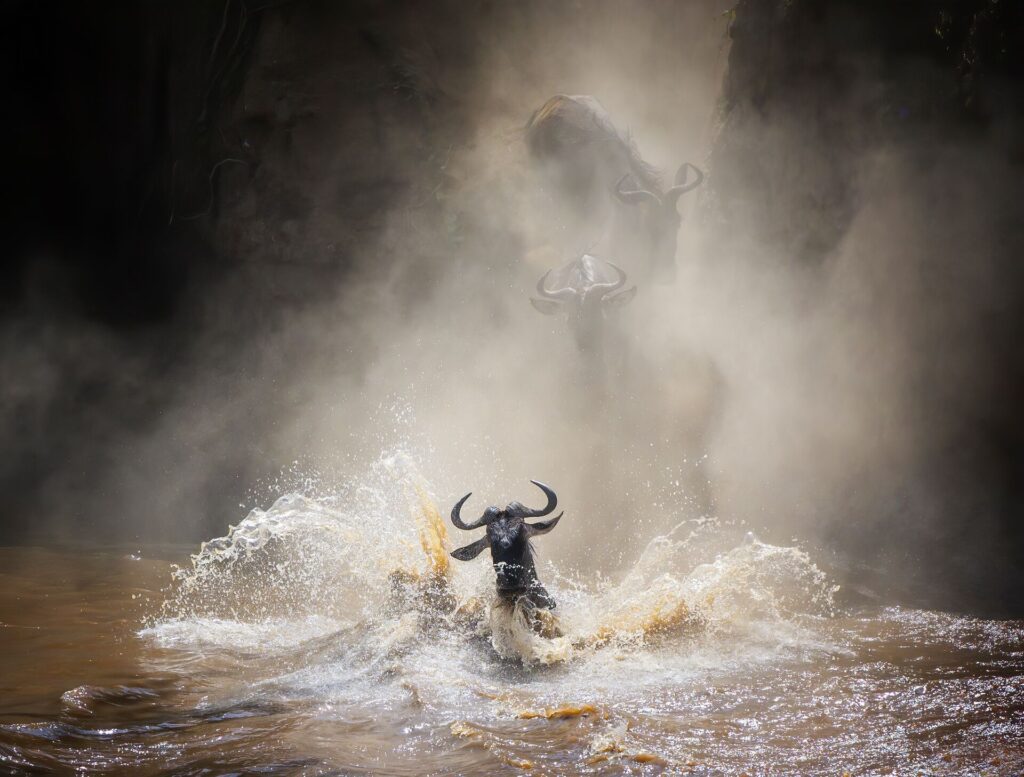

Where To See the Great Migration
You can experience the Great Migration in Kenya’s Maasai Mara National Reserve between July and October, and in Tanzania’s Serengeti National Park for the rest of the year, as the herds follow seasonal rains across these neighbouring regions.
Maasai Mara National Reserve (Kenya)
Located in southwestern Kenya, along the border with Tanzania, the Maasai Mara National Reserve spans some 151,000 hectares of protected savannah. It forms the northern extension of the Serengeti ecosystem and sets the stage for the most iconic moments of the Great Migration: the perilous Mara River crossings between July and October, when hundreds of thousands of wildebeest and zebras plunge into crocodile-infested waters enroute to greener pastures.
Named for the local Indigenous Maasai people and their word Mara – meaning ‘spotted’, a nod to the trees dotting the grasslands – the reserve is one of Africa’s most celebrated protected areas, thanks in part to conservation-minded local communities and their neighbouring conservancies.
Beyond the migrating herds, the Mara is legendary for its big cats, particularly lions, cheetahs and leopards, as well as elephants, giraffes, hyenas and more than 470 bird species. It’s also one of the few places in Kenya where you can reliably spot the Big Five – lion, leopard, elephant, buffalo and rhino – sometimes in a single game drive.
Serengeti National Park (Tanzania)
UNESCO World Heritage-listed for its ecological significance and astonishing wildlife density, Serengeti National Park covers 1.5 million hectares of northern Tanzania. Stretching from the Kenyan border in the north to the Ngorongoro Conservation Area in the south, it encompasses a range of habitats that support the Great Migration for most of the year – from sprawling short-grass plains in the south to acacia-dotted savannahs, riverine woodlands, and rocky outcrops in the north and west.
Alongside wildebeests and zebras, this diverse terrain supports massive populations of Thomson’s and Grant’s gazelles, buffalo, elephants, hippos, and some of Africa’s largest prides of lions. Cheetahs, jackals and hyenas are also common, especially during the migration when prey is abundant.
What sets the Serengeti apart is its sheer scale and largely uninterrupted wilderness – it’s one of the last places on Earth where such an epic, long-distance land migration unfolds, mostly free from the fences and roads that can fragment animals’ movement.
Experience the grandeur of the Maasai Mara on our 6-day fly-in adventure.
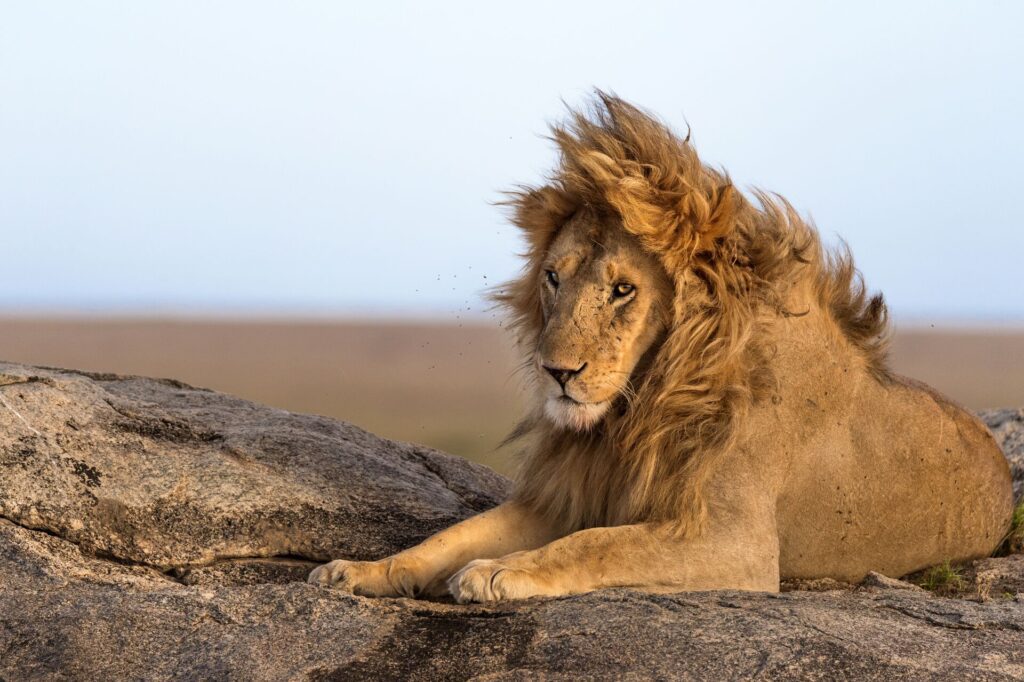

What Wildlife Can You See During the Migration?
You’ll have outstanding opportunities all year round, but the very best wildlife viewing coincides with the migration’s major movements: calving in the southern Serengeti (January to March) and the northern river crossings (July to August). While wildebeests dominate the spectacle, they’re trailed by a shadow of predators and scavengers. Lions, cheetahs, leopards and hyenas follow the herds closely, while smaller carnivores like jackals, servals and bat-eared foxes are more commonly seen during the calving season.
Elephants, hippos and buffalo move more independently, yet are often found on the migration’s path, especially in areas with permanent water sources. Giraffes, warthogs, eland, impala and gazelles also graze throughout the region, while crocodiles lie in ambush along the Grumeti and Mara Rivers. And the birdlife here is also prolific, with secretary birds, ostriches and kori bustards striding across the plains; vultures and raptors circling overhead, and migratory birds from Europe and Asia filling the wetlands from November to April.
Extend your adventure in Tanzania’s wildlife-packed Ngorongoro Crater.
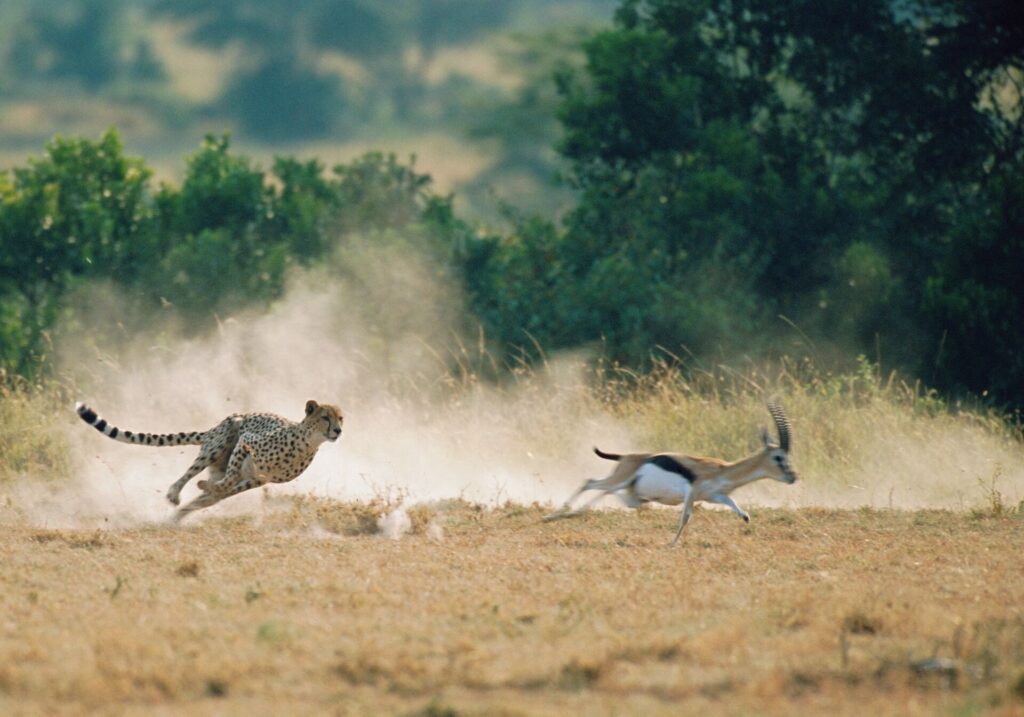

Why the River Crossings Are So Famous
While the migration is a year-round event, the Grumeti and Mara river crossings (typically between July and August) condense its most heart-stopping moments into an adrenaline-charged spectacle, where chaos and natural instincts collide. It begins with vast herds of wildebeests gathering at the water’s edge, hesitating for hours – sometimes days – before one brave animal makes the first move. That single step triggers a stampede as thousands charge forward, running the gauntlet through powerful currents and crocodile-infested waters, with only the strongest, and luckiest, making it across.
During the melee, calves are separated from mothers, some animals drown, and predators strike from both riverbanks and beneath the water’s surface. This all unfolds in a tense, unpredictable burst of motion that’s as photogenic as it is emotionally charged – nature at its raw, unfiltered best.
Take to the skies on the ultimate Kenya air safari.
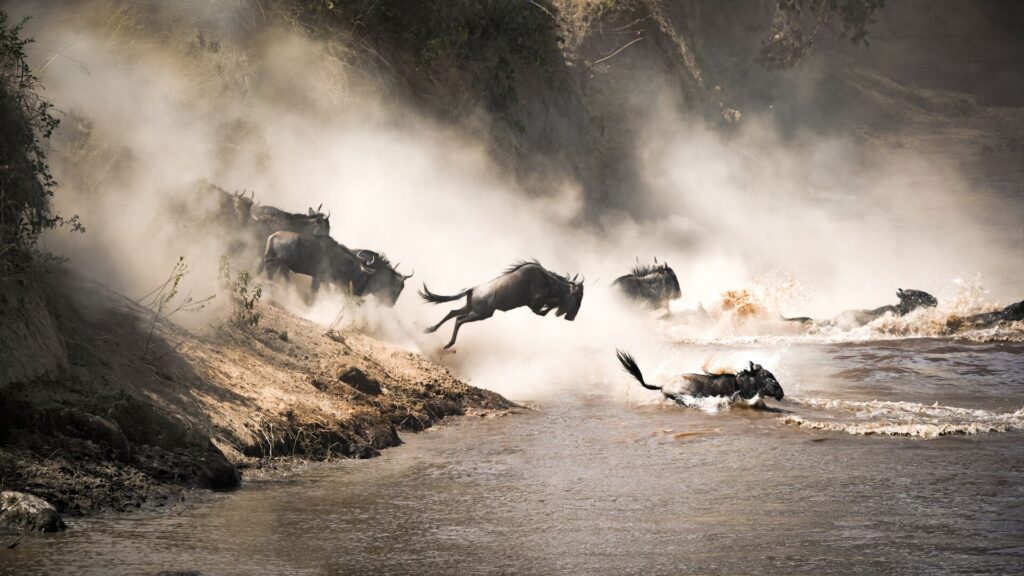

Tips for Travellers: What to Know Before You Go
Here, seven handy hints to help you plan your Great Migration safari holiday:
- Move with the animals. The great herds travel between Kenya and Tanzania all year round, so plan your timing and location based on what you most want to witness. For river crossings, aim for July–August in the northern Serengeti or Maasai Mara. For calving, head to the southern Serengeti between January and March.
- Consider staying in private conservancies. In both the Maasai Mara and Serengeti regions, private conservancies allow off-road driving and night safaris, offering more intimate wildlife encounters with fewer vehicles around. There are many excellent options across the ecosystem – speak to our Destination Experts for tailored advice.
- Think beyond the river crossings. While these are spectacular, the drama unfolds across the plains too, with predator hunts, mass calvings, and tense predator-prey standoffs all beyond the water’s edge.
- Visit during the shoulder seasons for quieter sightings. May to June and October to November offer active wildlife and fewer crowds, especially in the western corridor and central Serengeti. You may miss the river crossings, but you’ll enjoy broader access to other migration highlights.
- Stay longer than two or three nights. Animal movements are unpredictable, so give yourself 4 to 6 nights – ideally across different areas – to increase your chances of outstanding sightings. Curious about what a day on safari looks like? Check out our handy safari guide.
- Pack thoughtfully. Even in the dry season, mornings can be cool and afternoons hot. Pack light, especially if you’ll be flying on small aircraft with luggage limits. Choose breathable, quick-drying clothes in neutral tones to stay comfortable and avoid attracting insects. Don’t forget essentials like a wide-brimmed hat, sunglasses, sunscreen and insect repellent. Binoculars are a must for spotting wildlife, and if photography’s your thing, bring a camera with a zoom lens, along with spare batteries and memory cards. A refillable water bottle will keep you hydrated on game drives, and a headlamp or torch is useful after dark – red-light settings are ideal, as they’re less disruptive to the animals.
- Arrange your visas in advance. To ensure a smooth journey, check out the current visa requirements for both Kenya and Tanzania well ahead of time. For the most up-to-date advice, simply enter the country you want to travel to for information on safety regulations, border closures, quarantine requirements, your travel visa and more using the Sherpa travel tool: Visa Advice.
